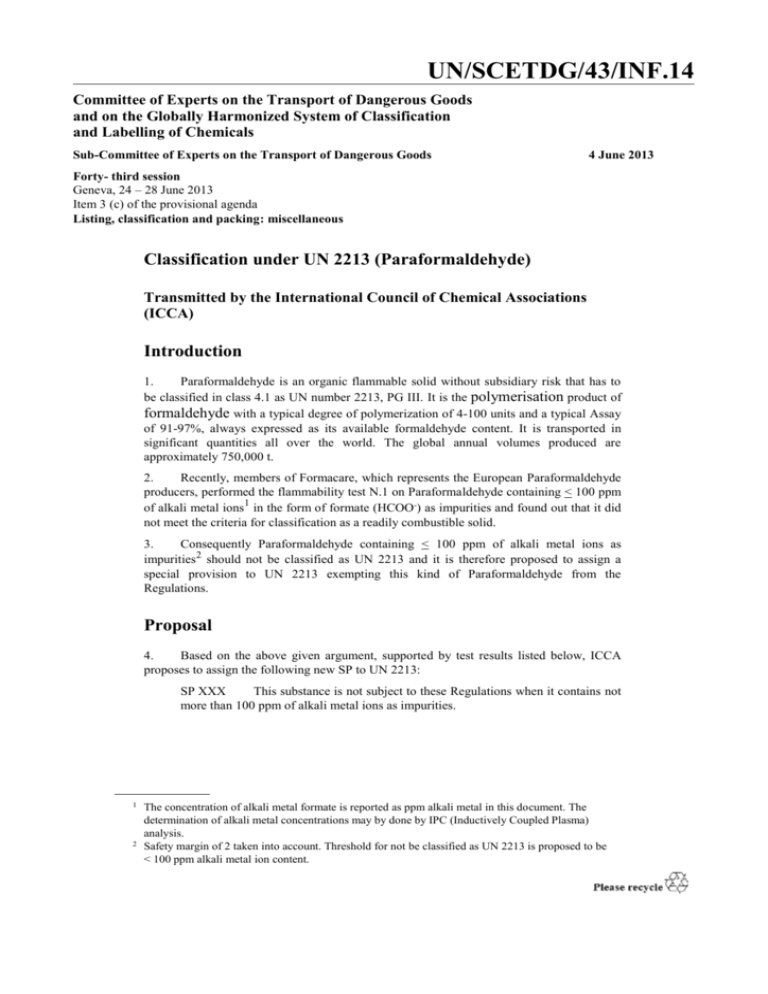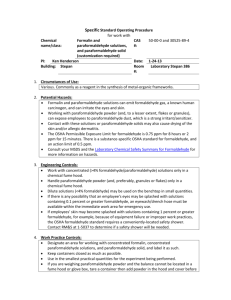United Nations
advertisement

UN/SCETDG/43/INF.14 Committee of Experts on the Transport of Dangerous Goods and on the Globally Harmonized System of Classification and Labelling of Chemicals Sub-Committee of Experts on the Transport of Dangerous Goods 4 June 2013 Forty- third session Geneva, 24 – 28 June 2013 Item 3 (c) of the provisional agenda Listing, classification and packing: miscellaneous Classification under UN 2213 (Paraformaldehyde) Transmitted by the International Council of Chemical Associations (ICCA) Introduction 1. Paraformaldehyde is an organic flammable solid without subsidiary risk that has to be classified in class 4.1 as UN number 2213, PG III. It is the polymerisation product of formaldehyde with a typical degree of polymerization of 4-100 units and a typical Assay of 91-97%, always expressed as its available formaldehyde content. It is transported in significant quantities all over the world. The global annual volumes produced are approximately 750,000 t. 2. Recently, members of Formacare, which represents the European Paraformaldehyde producers, performed the flammability test N.1 on Paraformaldehyde containing < 100 ppm of alkali metal ions1 in the form of formate (HCOO-) as impurities and found out that it did not meet the criteria for classification as a readily combustible solid. 3. Consequently Paraformaldehyde containing < 100 ppm of alkali metal ions as impurities2 should not be classified as UN 2213 and it is therefore proposed to assign a special provision to UN 2213 exempting this kind of Paraformaldehyde from the Regulations. Proposal 4. Based on the above given argument, supported by test results listed below, ICCA proposes to assign the following new SP to UN 2213: SP XXX This substance is not subject to these Regulations when it contains not more than 100 ppm of alkali metal ions as impurities. 1 2 The concentration of alkali metal formate is reported as ppm alkali metal in this document. The determination of alkali metal concentrations may by done by IPC (Inductively Coupled Plasma) analysis. Safety margin of 2 taken into account. Threshold for not be classified as UN 2213 is proposed to be < 100 ppm alkali metal ion content. UN/SCETDG/43/INF.14 Justification 5. Recently performed flammability tests, according to UN Test N.1 (Test method for readily combustible solids – section 33.2.1.4 of the UN Manual of Tests and Criteria), show different results depending on the presence of alkali metal ions as impurities. On behalf of 3 Paraformaldehyde manufacturers these tests were performed by the following independent testing laboratories: • Chilworth Global, Southampton, SO16 7NS, United Kingdom; • LAUS GmbH, D-67489 Kirrweiler, Germany; • JCS Technology, North Somerset, BS24 9BA, United Kingdom. A short description of the test results is provided in the following two paragraphs and a summary can be found in Table 1 in the Annex. 6. Tests performed with Paraformaldehyde which contains less than 100 ppm alkali metal ions in the form of formate as impurities: (a) Chilworth Global (2010): “Paraformaldehyde A-1”; sodium content: 7 ppm Summary: in the pre-test the sample Paraformaldehyde A-1 from Company A initially melted to a clear liquid then ignited with a small faint blue flame, which self-extinguished shortly after removal of the ignition source. Therefore no further testing was required and the test item should not be classified as a readily combustible solid of Division 4.1. (b) Chilworth Global (2011a): “Paraformaldehyde A-2”; sodium content: 7 ppm. Summary: In the screening test the test sample of another product from Company A was seen to ignite but no propagation was observed. Therefore no further testing was required and the test item should not be classified as a readily combustible solid of Division 4.1. (c) Chilworth Global (2011b): “Paraformaldehyde A-3”; sodium content: 7 ppm Summary: In the screening test the test sample of another product from Company A was seen to ignite but no propagation was observed. Therefore no further testing was required and the test item should not be classified as a readily combustible solid of Division 4.1. (d) LAUS (2010): granulated material “Paraformaldehyde B-1”; sodium content < 2 ppm, other alkali metal ions < 5 ppm, two other metal ions found in concentrations of 7 and 9 ppm, respectively in a screening test on 36 different metal elements by ICP. Formic acid (formate) < 300 ppm Summary: In the pre-test the sample from Company B, when heated with the gas burner, the test item melted, forming a liquid. The liquid started to boil and the boiling spot burned with an own flame. The flame died on its own when no boiling test item was present. Therefore no further testing was required and the test item should not be classified as a readily combustible solid of Division 4.1. (e) LAUS (2011): fine powder “Paraformaldehyde B-2”; sodium content 5 ppm, other alkali metal ions < 5 ppm, two other metal ions found in concentrations of 10 and 13 ppm, respectively in a screening test on 36 different metal elements by ICP. Formic acid (formate) < 300 ppm Summary: In a screening test, the sample of Company B was ignited with the flame of a Teclu burner. First, melting was observed, then, the test item started to burn with two seats of fire after 12 sec. Melting and no formation of smoke were observed. Combustion along 200 mm took 29 minutes and 37 seconds, much longer than 4 minutes. Therefore, the test item Paraformaldehyde B-2 should not be classified as a readily combustible solid of Division 4.1. 2 UN/SCETDG/43/INF.14 (f) JCS (2011): “Paraformaldehyde C-1”; sodium content: 18 ppm Summary: The test with material from Company C resulted into not classifying the sample as a readily combustible solid of Division 4.1. 7. Tests were also performed with Paraformaldehyde containing alkali metal ions in the form of formate as an impurity above 100 ppm: (a) JCS (2011a): “Paraformaldehyde C-2”; sodium content: 725 ppm Summary: the test sample of Company C was classified by JCS Technology as a readily combustible solid of Division 4.1. This conclusion was opposed in a second test by Chilworth Technology UK on a different sample of “Paraformaldehyde C-2” sodium content 645 ppm. These findings are consistent with the graph of Fig 2 , the specification range of “Paraformaldehyde C-2” (contains 90 – 92% Formaldehyde) and the flammability classification region (b) JCS (2011b): “Paraformaldehyde C-3”; sodium content: 608 ppm Summary: testing of the sample of Company C resulted into classifying the sample as a readily combustible solid of Division 4.1. This conclusion was further confirmed by another measurement by a second test by Chilworth Technology UK. (c) JCS (2011c):“Paraformaldehyde C-4”; sodium content: 620 ppm Summary: testing of the sample of Company C resulted into classifying the sample as a readily combustible solid of Division 4.1. 8. Company C also performed the following test: a grade of Paraformaldehyde C-5 of Company C that was prepared with an amine dope, was spiked with sodium formate and was mixed to make homogenous Paraformaldehyde samples containing 0.2% w/w, 0.4% w/w and 1% w/w sodium. During the test, the propagation time is being reduced (i.e. the flame spread increases) when the sodium concentration increases. The test conclusion would be that the presence of sodium thus affects the flammability properties and hence the classification of Paraformaldehyde. 9. Company C performed additional trials to make Paraformaldehyde under normal plant conditions with a range of increasing sodium content to reproduce exactly manufacturing conditions and test for Flammability. The Flammability screening time 3 of Paraformaldehyde containing Sodium ion (Na+) has been shown to decrease (increasing flammability) according to an increase in the Paraformaldehyde Assay expressed as its available Formaldehyde content for the same Sodium concentration and to decrease (increasing flammability) according to an increase in Sodium concentration for the same Formaldehyde content. 10. According to these results4 and to allow a reasonable margin of safety for the highest available Paraformaldehyde Assay of 97%, setting a limit of 100 ppm alkali metal ion will avoid the need to classify Paraformaldehyde as a Flammable solid Class 4.1 11. Meisel5 et al. investigated the thermal composition of alkali metal formates. Already at a temperature of 300 °C decomposition into flammable carbon monoxide and hydrogen 3 4 UN Transportation of Dangerous Goods – Class 4 Flammable Solids - Test Method N.1. Classifying solid materials as Flammable is done by applying a Screening test where samples are heated and if they catch alight, the time for them to burn along a length of 200mm is then measured. This is the Screening Test as burning times faster than 120 seconds require further testing to establish a Packing Group Classification, whereas times slower than 120 seconds result in a Non-Flammable Classification and no further testing. The results can be found in the Annex under figure 1 and 2. 3 UN/SCETDG/43/INF.14 takes place. This ready decomposition may cause the observed higher flammability of the Paraformaldehyde containing alkali metal formates as impurities. Conclusion 12. Tests with different fine and granulated materials on sale from various European manufacturers show that Paraformaldehyde should not be classified as a readily combustible solid of Division 4.1, if the test material contains less than 100 ppm of alkali metal ions. 13. As shown by tests performed by Company C the flammability of Paraformaldehyde depends both on the content of sodium metal ions and the Assay of Paraformaldehyde expressed as its available formaldehyde content. Paraformaldehyde with higher sodium content may behave differently and meet the criteria for classification as readily combustible solids of Division 4.1, depending on the amount of sodium ions and the Assay of Paraformaldehyde. 5 4 The thermal decomposition of Alkali Metal Formates, T. MEISEL, Z. HALMOS, K. SEYBOLD and E. PUNGOR, Journal of Thermal Analysis, Vol. 7 (1975) 73--80 UN/SCETDG/43/INF.14 Annex Table 1: Summary of test results Ref Substance6 6.a Paraformaldehyde A-1 (91%) (7 ppm Na+) Company A Performed by Chilworth Paraformaldehyde A-2 (92%) (7 ppm Na+) Company A Performed by Chilworth Paraformaldehyde A-3 (96%) (7 ppm Na+) Company A Performed by Chilworth Paraformaldehyde B-1 (91%) (< 2 ppm Na+) Company B Performed by Laus Paraformaldehyde B-2 (96%) (5 ppm Na+) Company B Performed by Laus Paraformaldehyde C-1 (96%) (18 ppm Na+) Company C Performed by JCS Paraformaldehyde C-2 (91%) (725 ppm Na+) Company C Performed by JCS – Paraformaldehyde C-2 (91%) (645 ppm Na+) Company C Performed by Chilworth Paraformaldehyde C-3 (97%) (608 ppm Na+) Company C Performed by JCS – confirmed by Chilworth Paraformaldehyde C-4 (97%) (620 ppm Na+) Company C Performed by JCS – confirmed by Chilworth 6.b 6.c 6.d 6.e 6.f 7.a 7b 7.c Preliminary screening test7 negative (self-extinguishing) Wetting solution delay time (min) Result NOT to be classified as Division 4.1. negative (no propagation) NOT to be classified as Division 4.1. negative (no propagation) NOT to be classified as Division 4.1. negative (flame died) NOT to be classified as Division 4.1. negative (combustion took > 29 minutes) NOT to be classified as Division 4.1. negative NOT to be classified as Division 4.1. Positive > 4 minutes To be classified as Division 4.1, PG III. positive > 4 minutes To be classified as Division 4.1, PG III positive > 4 minutes (5 runs), < 4 minutes (1 run) To be classified as Division 4.1, PG III Negative 6 Paraformaldehyde Assay expressed in available %formaldehyde in brackets. 7 UN Test N.1, section 33.2.1.4.3.1: ignition or propagation of combustion within 2 minutes. 5 UN/SCETDG/43/INF.14 Figures Figure 1: For constant levels of sodium ion concentration the Flammability screening time decreases (increasing flammability) with the Assay of Paraformaldehyde expressed as its available %Formaldehyde content 6 UN/SCETDG/43/INF.14 Figure 2: Maximum sodium ion concentration versus the Assay of Paraformaldehyde expressed as its available %Formaldehyde content. Decreasing Assay shows less risk of flammability for the same sodium concentration Proposed limit of impurity for Non- Flammability Classification 7








